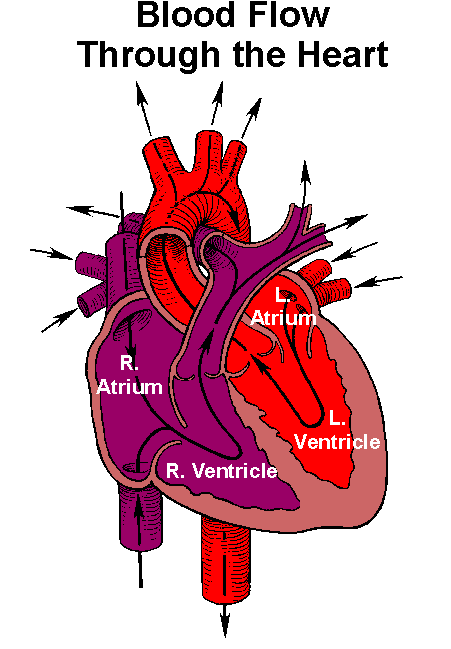Cardiovascular Emergencies Part I (1.5 Hours)

Review cardiovascular anatomy and physiology
Overview of the Heart
The heart is a powerful muscle, about the size of your fist. It is responsible for pumping blood to the entire body. In a healthy adult, the body contains about 2 gallons (5 liters) of blood that is circulated over and over through the body. The blood moves from the heart, into arteries, capillaries, and veins before returning to the heart. The entire cycle takes about 60 seconds, during which time the blood carries oxygen and nutrients to all the cells in the body. The blood vessels that bring oxygen and nutrients to the heart muscle itself are called the coronary arteries. The heart is divided into four compartments (chambers). Each upper chamber is called an atrium (plural atria) and each lower chamber is called a ventricle. The atrial septum divides the right and left atria. The ventricular septum divides the right and left ventricles. Blood from the body is carried into the heart’s right atrium by blood vessels called the vena cava. The Inferior vena cava brings blood from the legs and the lower part of the body. The Superior vena cava brings blood from the head, neck, and arms. When the right atrium fills with blood, it contracts, sending blood to the right ventricle. When the right ventricle fills with blood, it contracts, sending blood to the lungs through blood vessels called the pulmonary arteries. In the lungs, blood picks up oxygen, and then returns to the heart’s left atrium through blood vessels called the pulmonary veins. When the left atrium contracts, it sends blood to the left ventricle. From the left ventricle, blood is pumped out the aorta and through the body. Heart valves act as one-way doors, making sure that blood flows in the correct direction through the heart. Four valves control the blood flow in the heart:
- Tricuspid valve regulates blood flow from the right atrium into the right ventricle.
- Pulmonary valve regulates blood flow from the right ventricle into the pulmonary arteries
- Mitral valve regulates blood flow from the left atrium to the left ventricle.
- Aortic valve regulates blood flow from the left ventricle to the aorta.
